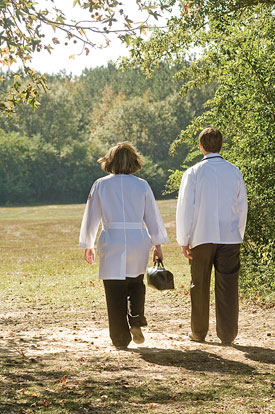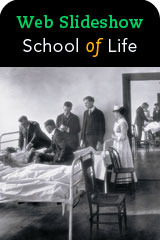Improving the State of Care
By Jo Lynn Orr
 |
Rural medicine students gain clinical experience working with small-town physicians throughout Alabama. |
The idea seems so simple now: a round-the-clock telephone hotline to UAB specialists. But for physicians in rural Alabama in 1969, that hotline was a lifeline when they needed advice or answers from colleagues. It also is one example of how the School of Medicine has cultivated relationships with rural physicians since the Mobile medical school was founded to train much-needed doctors for the state’s communities.
When it was created, the toll-free line, known as MIST (Medical Information Service via Telephone), took advantage of communications breakthroughs like conference calling to connect outlying physicians with UAB doctors for medical consultations. Program manager Lynn Watson recalls one physician summing up MIST’s success by declaring, “I can practice in rural Alabama because I have three things: a beeper, a cell phone, and the MIST number.” Over the past four decades, MIST has inspired similar programs nationwide.
Disasters such as Hurricane Katrina and news about infectious disease pandemics prompt an increase in calls, Watson says. “We see those kinds of trends,” she explains, “especially when HIV hit and there was a surge in new infections in the South, particularly the outlying areas, in the 1990s. Since then, we have experienced a large number of calls because people are more aware of the service.”
MIST’s latest innovation is the addition of a transfer center nurse on referral calls. “Physicians anywhere in the continental United States who want to refer a patient to UAB can contact MIST, and we will connect them with both our accepting physician and the transfer center nurse at the time of the call,” Watson explains. “The nurse then oversees the transfer of the patient to UAB. This approach helps triage the call, with everyone involved in the transfer on the line at the same time. Critical-care transport also can be included if those services are needed.”
Preparing Rural Physicians
Some of those callers may soon be alumni of the SOM’s rural medicine programs. Designed to attract and train high-achieving students from outlying counties who are committed to opening practices in those communities, the Rural Medical Scholars Program (RMSP) and the Rural Medicine Program (RMP) help meet the pressing need for physicians in underserved areas. According to a 2004 report by the state Medical Licensure Commission, several Alabama counties had fewer than 10 doctors; Coosa County had only one.
 |
MIST has operated 24 hours a day, seven days a week for 40 years. Photo courtesy of UAB Archives. |
The RMSP, based at the SOM branch campus in Tuscaloosa, was established a decade ago; the RMP, at the school’s Huntsville Regional Medical Campus, began in 2007. Ten new students join the Tuscaloosa program each year, beginning with a prematriculation year at the University of Alabama. The Huntsville program brings in six students annually for an initial year at Auburn University. Through courses and field experiences, the preparatory year teaches “skills helpful to rural physicians such as epidemiology as it applies to underserved populations, or disparate outcomes of rural and racially underserved populations, or health-care reform, or about rural practice itself,” says William A. Curry, M.D., FACP, SOM associate dean for primary care and rural health. “For instance, how does a health-care system in a rural community compare to an urban system? What’s the physician’s place in that community?” Following two years of medical school in Birmingham, the students return to the branch campuses for clinical training and rural rotations.
While Huntsville’s first rural medicine class is now in Birmingham, the members of Tuscaloosa’s first class have opened their practices, with the second group soon to follow. “Of those in practice, five are in primary care—four in family medicine and one in general internal medicine,” Curry says. “That’s a much greater percentage than most medical-school graduates across the board.”
Curry emphasizes that the SOM offers other rotations in underserved or rural locations, providing all students and residents with “a terrifically rewarding experience. We have to prepare our future physicians for various models of practice, depending on community needs and opportunities,” he says. “Every part of our medical enterprise, whether it’s educational, service, or research, has a stake in rural Alabama to help improve its health care.”

